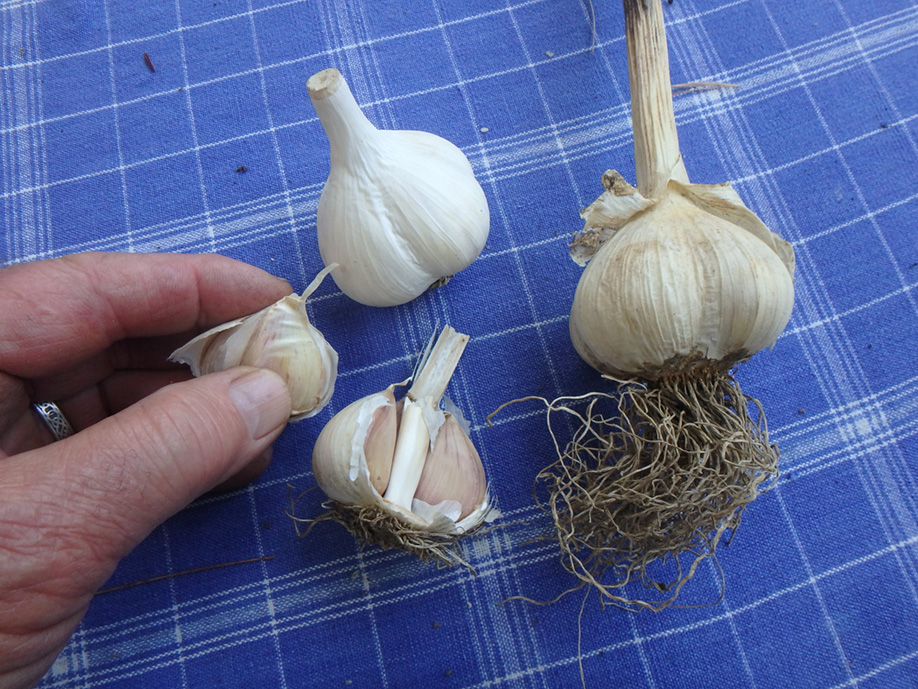
courtesy photo
Hard neck garlic cloves surround a stiff neck and are best for New England gardens.
CORNISH FLAT, N.H. – If you lean toward lazy (or have kids, dogs and a job), growing garlic may be just the ticket. It is the easiest of all vegetables to grow. Once planted and mulched, it requires little or no work until harvest. A good harvest is guaranteed if you follow my instructions. Even with all the strange weather we’ve seen, I’ve never had a bad crop in the past 25 years or so of growing garlic.
Now is the time to buy garlic for planting unless you have some from your own garden saved for that purpose, as I do. You’ll want to get your garlic planted a month before the ground freezes, so depending on where you live, you may want to plant some soon. Garlic needs to establish roots now, and is not generally planted in the spring.
There are two categories of garlic: hard neck and soft neck. Both will grow in New England, but hard neck is the type grown by most farmers, and the most cold-hardy. It produces a stiff scape or stem each summer that is edible. Soft neck garlic generally comes from California, and is good in the kitchen; it is also the type braided and hung from the ceiling in Italian restaurants as decoration. Hard neck garlic generally has more flavor; a wide variety of flavors is possible, depending on the type you grow.

courtesy photo
Garlic grows through the mulch, shown here in May.
Garlic does best in rich soil that drains well. If you have a heavy clay soil (one that is sticky when wet), you will need to add plenty of compost to your soil. Adding sand will not help, as sand added to heavy clay produces something like concrete that hardens up in dry times.
If you have poor soil, you may want to build a wood-sided raised bed, and add plenty of compost and topsoil that you purchase in bulk or in bags. I find Moo-Doo brand composted cow manure and topsoil are good soil additives that are sold in bags in many garden centers. A 50-50 mix of your soil (or purchased topsoil) and compost should work well.
When making a wood-sided bed, I don’t recommend treated lumber. Even though most treated lumber is safe to handle and much less toxic than 20 years ago, I don’t want any chemicals leaching into my soil. I use rough-sawn lumber from a local sawmill, preferably hemlock. It generally lasts about 10 years. Eight-inch wide planks are wide enough to make a nice box.
Plain pine boards will work, too, and metal corners are readily available at garden centers or from catalogs like Gardeners Supply and Lee Valley Tools. The corners make constructing a garden box easy even for non-carpenters. All you need is a cordless drill to drive the screws. Carrots and other root crops do well in garden boxes, so you can alternate them with garlic in subsequent years if you build two or more boxes.

courtesy photo
Place your garlic cloves on the soil to establish spacing before planting.
I generally use my own garlic for planting, as it has adapted to my soil and climate over the years. But if I see big, fat bulbs of garlic at a farmers market, I sometimes buy some. I don’t recommend buying garlic for planting at the grocery store as most has been treated to prevent it from germinating, and so it will last longer.
Where can you get garlic for planting? If there is none at your local farmers market, you can get organic garlic from Johnny’s Selected Seeds in Maine (877-564-6697 or johnnyseeds.com). But don’t wait too long: they sell out most years.
Once the soil is loose and weed-free, I plant. I take a CobraHead weeder, a nice single-tined weeder, and make furrows in the soil of my raised bed. I keep the furrows about eight inches apart. I sprinkle some organic bagged fertilizer into each row, and stir it in.
I break the garlic bulbs apart, separating the cloves. There are usually 5 to 10 cloves per head. I push the cloves into the loose soil, pointy end up, about three inches deep, and four inches apart. I cover with soil, and then pat it gently.
The last step is key if you want a weed-free garlic bed: put a foot of fluffy mulch hay or straw over the planted garlic. The straw will pack down over the winter and make a nice mulch that will keep most weeds from growing, but the garlic will push through it. It will be ready to harvest next July.
Depending on when you plant, the soil temperature, and when real cold weather comes, your garlic may send up a few green shoots this fall. Don’t panic. It won’t hurt your garlic. When cold weather comes, it will go dormant and do just fine next spring.
I believe that garlic is a healthy and tasty addition to my diet. It may even be medicinal: it has been used that way for centuries. Some believe that if you crush your garlic and then wait 10 minutes before cooking, it will generate cancer-fighting compounds. Who knows? Certainly it can’t hurt.
And this winter if you chew on a clove of garlic before going to the store, you’ll never get a cold because people will stand back from you in line!
[Homeyer lives in Cornish Flat, N.H. He is the author of four gardening books and is a UNH Master Gardener. His e-mail is [email protected].]






